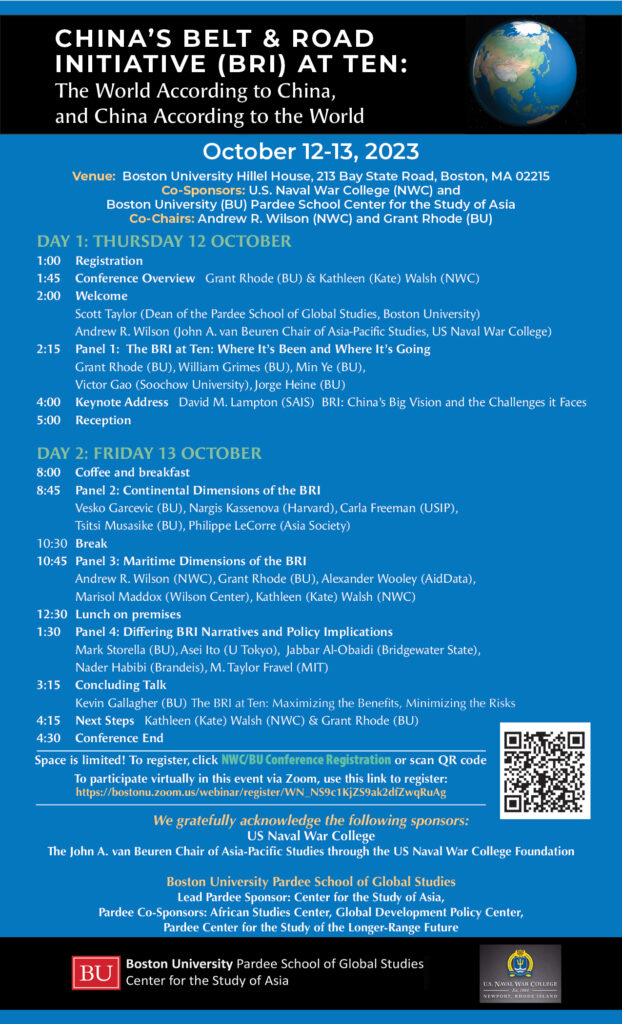In an imaginative stroke connecting the past with the present, Chinese President Xi Jinping used the powerful metaphor of the ancient silk roads to brand his signature foreign policy as the Belt and Road Initiative (BRI), a brand that has had a significant success in the global marketplace of ideas. The scale and ambition of Xi Jinping’s reimagined Silk Roads were obvious early on, as was the potential of the project to transform the global economy and potentially the global balance of power. Over its first decade, the BRI attracted significant attention worldwide. By August 2023,155 countries had signed up to be part of the BRI. These participating countries account for 75% of the world’s population and for more than half of global GDP. During the decade 2013-2023, China invested approximately US$1 trillion in projects across Asia, Europe, the Middle East, Africa, and Latin America. The BRI has had economic and political impact commensurate with its broad scope, including results marked by both benefits and risks.
Scholars at the Pardee School of Global Studies began studying the BRI at the time of its announcement in 2013 and have continued to the present time, collaborating with a wide group of scholars from Asia, Africa, Europe, and Latin America. During the first decade of the BRI, these scholars have been brought together in two programs spearheaded by the Boston University Center for the Study of Asia (BUCSA). Dr. Grant Rhode directs Assessing China’s Belt and Road Initiative (BRI) for BUCSA. He initiated and coordinated the following programs and prepared this webpage which makes available key findings of scholars involved in analysis of the BRI.
- Book publication release is expected Summer 2026: Pardee School faculty members Professors Min Ye, Jorge Heine, and Grant Rhode, coordinating with U.S. Naval War College Professor Andrew (Dex) Wilson, edited a manuscript based on the October 2023 conference papers. The book is in production for publication by Harvard University Press. It is titled Investigating the Belt and Road: China According to the World and the World According to China.
- In-person BRI conference, October 12 & 13, 2023: The two-day conference included two keynote addresses and four panels with four speakers each addressing the topic The BRI at Ten: China According to the World and the World According to China.
- Pandemic virtual BRI series, August 2020 through November 2021: The series included fifteen 90-minute webinars Assessing China’s Belt and Road Initiative with speakers, discussants, and Q&A sessions on a series of wide-ranging BRI topics.
October 12 & 13, 2023, Conference Summary and Video Links:
THE BRI AT TEN: CHINA ACCORDING TO THE WORLD AND THE WORLD ACCORDING TO CHINA

1. To download the detailed conference program and information about the speakers, click HERE
2. Videos of the following presentations and panels are now available by clicking below:
• Keynote Address: David M. Lampton, “China’s Big Vision and the Challenges It Faces”
• Panel 1: “The BRI at Ten: Where it’s Been and Where It’s Going”
William Grimes, Min Ye, Victor Gao, Jorge Heine, Grant Rhode moderator
• Panel 2: “Continental Dimensions of the BRI (The Belt)”
Nargis Kassenova, Carla Freeman, Tsitsi Musasike, Philippe Le Corre, Vesko Garcevic moderator
• Panel 3: “Maritime Dimensions of the BRI (The Road)”
Grant Rhode, Alexander Wooley, Marisol Maddox, Kathleen Walsh, Andrew R. Wilson moderator
• Panel 4: “Differing BRI Narratives and Policy Implications”
Asei Ito, Jabbar Al-Obaidi, Nader Habibi, M. Taylor Fravel, Mark Storella moderator
• Keynote Address: Kevin Gallagher, “The BRI at Ten: Maximizing the Benefits and Minimizing the Risks”
3. To download the conference summary prepared by Rebin Najmalddin (BU), click HERE
4. Papers from this BRI at Ten conference have been expanded and updated into chapters for a forthcoming conference volume currently in the process of publication review. Watch this space for updated information as it nears publication.
August 2020 through November 2021, Virtual Video Series:
ASSESSING CHINA’S BELT AND ROAD INITIATIVE
This conference builds upon the Pardee School’s previous presentation series, Assessing China’s Belt and Road Initiative, which was held during the 2021-2022 academic year. The links below will take you to those recorded sessions.
Fall 2021 BRI links:
Sep 17, 2021: Selina Ho, Carla Freeman, and Jessica Liao on “Dam Diplomacy? Chinese Dam Building and Water Disputes in Asia”
Oct 1, 2021: Wendy Leutert and Isaac Kardon on “Economic and Security Aspects of China’s Global Port Development”
Oct 15, 2012: Nader Habibi and Adel Abdel Ghafar on “China’s Economic Relations with the Levant Region”
Oct 29, 2021: Lina Benabdallah and Michael Woldemariam on “Chinese Social Capital Networks in North Africa”
Nov 12, 2021: Lyle Goldstein and Abbie Tingstad on “The Russia-China Quasi-Alliance and the Polar Silk Road”
Spring 2021 BRI links:
Feb 5, 2021: Kevin Gallagher and William Grimes on “BRI Economic Benefits and Risks”
Feb 19, 2021: Min Ye and Shifrinson on “US-China Strategic Competition and the BRI”
Mar 5, 2021: Ambassador Jorge Heine on “Is China’s New Silk Road Lending a Helping Hand in Latin America’s Current Crisis?”
Mar 12, 2021: Professor David M. Lampton and Joseph Fewsmith on Rivers of Iron: Railroads and Chinese Power in Southeast Asia
Mar 19, 2021: William Grimes and Bart Edes on “BRI Lessons from Japan: From Flying Geese to Partnership for Quality Infrastructure”
Apr 2, 2021: Deborah Brautigam on “Áfrican Debt Relief with Chinese Characteristics.”
Apr 16, 2021: Philippe Le Corre on “Italy and Greece: Two Case Studies for Chinese Involvement in Southern Europe”
Fall 2020 BRI book talks:
Aug 12, 2020: Min Ye on The Belt Road and Beyond: State-Mobilized Globalization in China, 1998-2018
Oct 13, 2020: Jonathan Hillman on The Emperor’s New Road: China and the Project of the Century
Dec 4, 2020: Kent Calder on Super Continent: The Logic of Eurasian Integration
